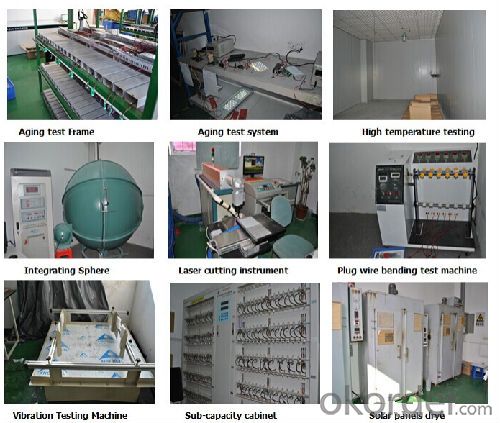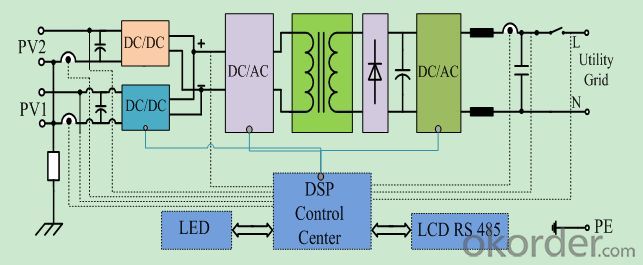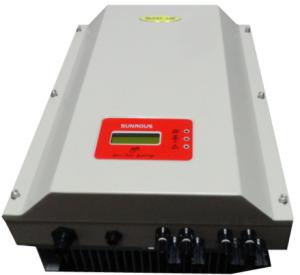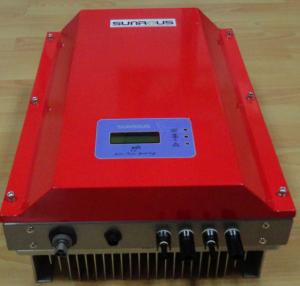Grid-Tied Inverter Dual MPPT Made in China with Good Price
- Loading Port:
- Shanghai
- Payment Terms:
- TT or LC
- Min Order Qty:
- 100 mm
- Supply Capability:
- 500 mm/month
OKorder Service Pledge
OKorder Financial Service
You Might Also Like
·High frequency transformer isolation and conversion efficiency rate up to 97%.
·Dual input sections with independent MPP tracking, allows optimal energy harvesting from two sub-arrays oriented in different directions
· High speed and precise MPPT algorithm for real time power tracking and improved energy harvesting, as well as regular MPP Adaptation Efficiency of over 99.0%.
·Flat efficiency curves ensure high efficiency at all output levels ensuring consistent and stable performance across the entire input voltage and output power range
·Wide input DC MPPT range(150V~550V)/output AC voltage range (180V~264V)
·IP 65/NEMA 3R, outdoor enclosure for unrestricted use under any environmental conditions
·Any modules can be used and fit in this device whether crystalline or thin-film.
·Use in residential applications requiring PV array plug-in grounding.
·RS-485 communication interface (designed for connection to computer or data-logger)
·Easy to install and operate with reduced weight.


High frequency transformer isolation is the main feature of our production, which makes Installation easier due to the reduced weight and higher conversion effciency because of omitting Low frequency transformer. The wide input voltage range from 180 to 600voltage gives you extraordinary fexibility for you system design. Not need to set graphic display and RS485 communication system make the devices highly user-friendly.
This product can by multi-level parallel combination for 6kw to 20kw needed any power grade HF series technical parameter.
certificates:
American ETL certification
- GT2.0-ZX-01/HF
- GT3.0-ZX-01/HF
The European TUV certification
- GT2.0-ZX-01
- GT2.5-ZX-01
- GT3.0-ZX-01
The British G59 authentication
- GT3.8-ZX-01
- GT5.0-ZX-01
The British G83 authentication
- GT2.0-ZX-01
- GT2.5-ZX-01
- GT3.0-ZX-01
Model No. | PR-SAS300 |
Polycrystalline solar panel | 2pcs 75Wp parallel |
Max. solar panel charging voltage | 17.6V |
Max. solar panel charging current | 8.54A |
Inverter output | Pure sine wave 300W |
Inverter peak start | 900W (3s) |
Inverter output voltage/frequency | 220V/50Hz |
Inverter AC charger | 12V/10A |
Solar charge controller | 12V/15A |
Cabinet material | Steel box of zinc-plated and lacquer-coated |
Battery type | Deep cycle maintenance free |
Battery capacity | 1 x 12V 100Ah |
Operating temperature | -20oC-55oC |
Packing for solar panel | 0.06cbm/20kg |
Packing for integrated solar charge control inverter cabinet | 0.11cbm/15kg |
Packing for battery | 0.02cbm/31kg |
Whole system per set | 0.19cbm/66kg |
Optional monitoring software | CD-ROM for computer and SNMP card for internet |
Q1 : What is you advantages
A1:
a).We are professional ups manufacturer for more than ten years and we have these staffs with rich
production and R&D
b) Excellent workers and skilled engineers
c).Our aims are to provide every customer high quality, reasonable price and excellent
service.
d)we can guarantee to send the goods on time. And also accept any transportation ways that
you require
Q2 : How do you control the production quality
A2:
a) For materials, we have IQC departments and the IQC testing follow MIL-STD-105E standard
b) in production have 4 times function testing
c) all of our products with 100% burn-in testing
d) 100% QC testing before delivery
- Q:Can a solar inverter be used with a solar-powered electric gate system?
- Yes, a solar inverter can be used with a solar-powered electric gate system. The solar inverter is responsible for converting the direct current (DC) produced by the solar panels into alternating current (AC) that can be used to power the electric gate system. This allows for efficient and reliable operation of the gate system using solar energy.
- Q:How does a solar inverter handle low light conditions or cloudy days?
- A solar inverter handles low light conditions or cloudy days by adjusting its power output to match the available sunlight. It is designed to maximize the energy conversion efficiency even in low light situations, allowing for continuous power generation from the solar panels.
- Q:Are solar inverters compatible with different solar panel technologies?
- Yes, solar inverters are generally compatible with different solar panel technologies. Most modern solar inverters are designed to work with a wide range of solar panel technologies, including monocrystalline, polycrystalline, and thin-film panels. However, it is always recommended to check the specifications and compatibility of the specific inverter with the desired solar panel technology before making a purchase.
- Q:How does the input power rating affect the performance of a solar inverter?
- The input power rating of a solar inverter directly affects its performance. A higher input power rating allows the inverter to handle a greater amount of solar energy, resulting in a higher energy conversion efficiency and overall performance. On the other hand, a lower input power rating may limit the inverter's capacity to handle larger solar systems, potentially leading to lower efficiency and reduced performance. Therefore, selecting an inverter with an appropriate input power rating is crucial to ensure optimal performance in a solar energy system.
- Q:What happens to excess solar energy generated by the inverter?
- Excess solar energy generated by the inverter can be either stored in batteries for later use or fed back into the electrical grid, depending on the setup of the solar power system.
- Q:What is the role of reactive power control in a solar inverter?
- The role of reactive power control in a solar inverter is to maintain the power factor of the system by managing the flow of reactive power. This helps to improve the overall efficiency and stability of the solar power generation system. Reactive power control ensures that the inverter can supply or absorb the necessary reactive power to balance the system, compensate for reactive power losses, and meet the grid requirements.
- Q:Can a solar inverter be used with a solar-powered outdoor lighting system?
- Yes, a solar inverter can be used with a solar-powered outdoor lighting system. The solar inverter converts the direct current (DC) generated by the solar panels into alternating current (AC) that can power the outdoor lighting system.
- Q:Can a solar inverter be used with a monitoring system?
- Yes, a solar inverter can be used with a monitoring system. In fact, many solar inverters are equipped with built-in monitoring capabilities, allowing users to track the performance and output of their solar energy system in real-time. Additionally, there are also external monitoring systems available that can be integrated with a solar inverter to provide more advanced monitoring features and data analysis.
- Q:Can a solar inverter be used with different battery chemistries?
- Yes, a solar inverter can be used with different battery chemistries as long as the inverter is compatible with the specific chemistry. However, it is important to ensure that the inverter is designed to support and optimize the charging and discharging characteristics of the specific battery chemistry being used for optimal performance and longevity.
- Q:What is the difference between a central inverter and a string inverter?
- A central inverter is a single large inverter that is responsible for converting the DC power generated by multiple solar panels into AC power for use in a building or to be fed back into the grid. On the other hand, a string inverter is a smaller inverter that is connected to a string of solar panels, typically between 6 to 20 panels, and converts the DC power generated by that specific string into AC power. The main difference is that a central inverter is used for larger solar installations, while string inverters are more commonly used in smaller residential or commercial installations.
1. Manufacturer Overview |
|
|---|---|
| Location | |
| Year Established | |
| Annual Output Value | |
| Main Markets | |
| Company Certifications | |
2. Manufacturer Certificates |
|
|---|---|
| a) Certification Name | |
| Range | |
| Reference | |
| Validity Period | |
3. Manufacturer Capability |
|
|---|---|
| a)Trade Capacity | |
| Nearest Port | |
| Export Percentage | |
| No.of Employees in Trade Department | |
| Language Spoken: | |
| b)Factory Information | |
| Factory Size: | |
| No. of Production Lines | |
| Contract Manufacturing | |
| Product Price Range | |
Send your message to us
Grid-Tied Inverter Dual MPPT Made in China with Good Price
- Loading Port:
- Shanghai
- Payment Terms:
- TT or LC
- Min Order Qty:
- 100 mm
- Supply Capability:
- 500 mm/month
OKorder Service Pledge
OKorder Financial Service
Similar products
New products
Hot products
Hot Searches
Related keywords































